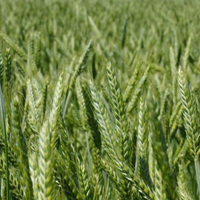Forage and grain yields of dual-purpose triticale as influenced by the integrated use of Azotobacter chroococcum and mineral nitrogen fertilizer

Accepted: 18 November 2020
PDF: 789
All claims expressed in this article are solely those of the authors and do not necessarily represent those of their affiliated organizations, or those of the publisher, the editors and the reviewers. Any product that may be evaluated in this article or claim that may be made by its manufacturer is not guaranteed or endorsed by the publisher.
The utilization of dual-purpose cereals is encouraged in the Mediterranean environments to fill a feed gap during the winter season. Triticale is a promising dual-purpose crop for forage and grain production. Studies on the variations in productivity and quality of dual-purpose triticale under variable fertilization management are scarce. This study was carried out during winter 2018/2019 and 2019/2020, in Northern Egypt, to evaluate the performance of triticale grown in dual-purpose and grain-only production systems under variable mineral N (mN) rates (zero, 25, 50, 75% of the recommended), accompanied with Azotobacter chroococcum (AC) seed inoculation, as well as 100% mN application without AC. The application of 50% mN with AC seed inoculation resulted in an average of 7.23, 7.27 t ha–1, forage and grain yields, respectively. Moreover, forage and grain crude protein reached 125.57, and 200.60 g kg–1, respectively. Forage fibre fractions were non-significantly variable among the fertilizer treatments. Azotobacter chroococcum seed inoculation, thus, allowed for the reduction of the used amount of mN to 50% without sacrificing the forage and grain yields and protein content. In the dual-purpose system, an average of 7.23 t ha–1 forage yield was obtained with little reduction in the grain yield (19% reduction in average). Meanwhile, grain crude protein content was higher in dual-purpose system (201.38 g kg–1) than in grain-only system (182.98 g kg–1). In similar conditions to the current study, it is recommended to expand the production of dual-purpose triticale in the winter while reducing mN fertilizer rate to 50% in combination with AC seed inoculation.
Highlights
- Triticale is a promising dual-purpose crop that can be utilized for forage and grain production under irrigated Mediterranean conditions.
- Around 7.23 t ha–1 forage yield was obtained from the dual-purpose triticale with a slight decrease (19% in average) in final grain yield.
- Dual-purpose production system was profitable due to the good prices of triticale green forage in the region.
- Azotobacter chroococcum seed inoculation allowed for the reduction of mineral nitrogen rate to 50% without sacrificing the forage and grain yields.
- The integrated use of Azotobacter chroococcum seed inoculation with mineral nitrogen resulted in 43% decrease in fertilization costs.
How to Cite

This work is licensed under a Creative Commons Attribution-NonCommercial 4.0 International License.
PAGEPress has chosen to apply the Creative Commons Attribution NonCommercial 4.0 International License (CC BY-NC 4.0) to all manuscripts to be published.

 https://doi.org/10.4081/ija.2020.1719
https://doi.org/10.4081/ija.2020.1719



